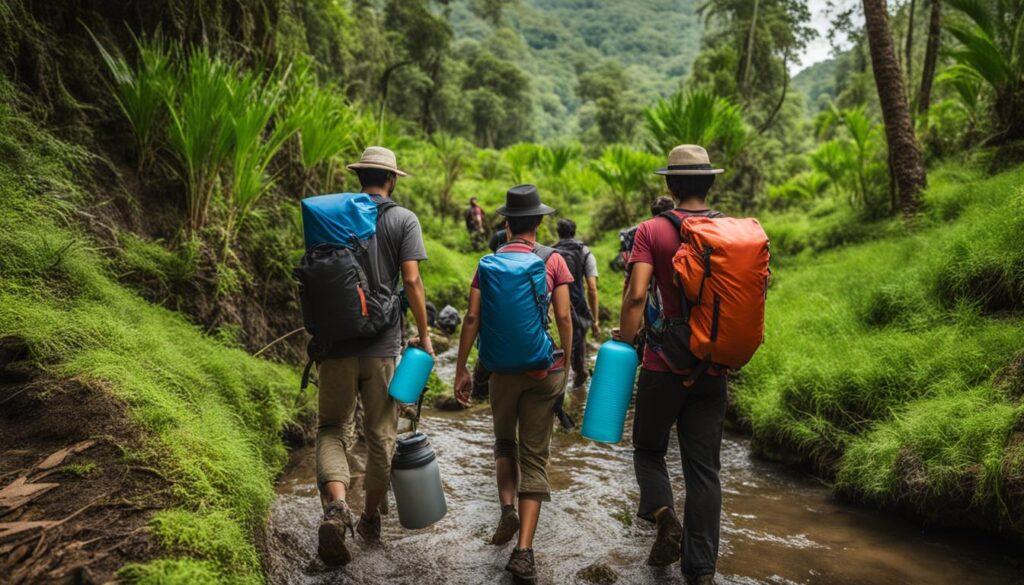Are you a conscious traveler looking for ways to reduce your environmental impact while exploring new places? Consider regenerative tourism – a sustainable travel approach that prioritizes ecosystem restoration, cultural preservation, and community empowerment.
Regenerative tourism is different from traditional tourism practices that often prioritize profits over sustainability. It focuses on nurturing and restoring the ecosystems and communities of destinations, ensuring that they remain viable and vibrant for generations to come.
By choosing regenerative tourism, you can enjoy eco-friendly travel experiences that contribute to the preservation of natural resources and support local communities. Whether you’re interested in nature-based or community-based tourism, regenerative tourism can offer numerous benefits for both travelers and destinations.
Keep on reading to learn more about regenerative tourism and how you can incorporate this sustainable travel approach into your next adventure.
Understanding Regenerative Tourism
Regenerative tourism is a concept that centers around revitalizing the ecosystems, cultures, and communities of travel destinations. It aims to leave these places better than they were found, focusing on sustainability and responsibility. By practicing regenerative tourism, you can make a positive impact on the environment, economy, and community.
Principles and objectives of regenerative tourism involve:
- Nurturing and restoring ecosystems
- Preserving cultural heritage
- Creating economic opportunities for local communities
- Enhancing traveler well-being
Regenerative tourism is not just about avoiding negative impacts but goes further by actively improving the natural environment and the social and cultural assets of local communities.
To better understand regenerative tourism, it’s crucial to recognize the difference between traditional tourism and regenerative tourism. While traditional tourism often involves exploiting the resources of a destination for the benefit of the traveler, regenerative tourism focuses on creating a mutually beneficial relationship between travelers and the destination, leaving behind positive impacts.
“Regenerative tourism is about creating a better world, one journey at a time.”
The Benefits of Regenerative Tourism
Regenerative tourism practices not only help sustain the environment, but also bring about various benefits to the travelers and the communities they visit. Here are some of the significant benefits of regenerative tourism:
Nature-Based Tourism
Regenerative tourism can take the form of nature-based tourism, which allows travelers to experience and appreciate natural landscapes, wildlife, and biodiversity. This type of tourism promotes nature conservation and supports initiatives that preserve and protect valuable ecosystems, such as coral reefs, rainforests, and wetlands. Additionally, picking eco-friendly activities like hiking, birdwatching, and snorkeling, can take you closer to the natural wonders and offer exceptional experiences.
Community-Based Tourism
Regenerative tourism actively engages local communities and provides opportunities for them to benefit economically and socially. Travelers who seek authentic cultural experiences can choose community-based tourism, which focuses on exploring local traditions, crafts, and lifestyles. Through this type of tourism, local communities can preserve their cultural heritage and prosper economically.
Sustainable Tourism
Regenerative tourism practices prioritize the well-being of local communities and the environment. Thus, it fosters sustainable development while reducing carbon footprints, waste generation, and environmental pollution. Sustainable tourism practices include decreased energy consumption, utilization of renewable energy sources, and an emphasis on low-impact travel options, amongst others.
| Benefits | Description |
|---|---|
| Preservation of natural resources | Regenerative tourism actively supports nature conservation and protects valuable ecosystems. |
| Promotes community empowerment | This type of tourism provides opportunities for local communities to benefit economically and socially, thus preserving cultural heritage and traditions. |
| Fosters sustainable development | Regenerative tourism practices prioritize the well-being of local communities and the environment, supporting sustainable development and reducing environmental pollution. |
Image related to nature-based tourism
Through regenerative tourism, travelers can positively impact the communities and destinations they visit. Engage in regenerative practices and contribute to the preservation of natural environments, promotion of community empowerment, and foster sustainable development.
Implementing Regenerative Practices
You can make a positive impact on the environment and local communities by implementing regenerative practices while traveling. Consider the following tips to align your trips with regenerative tourism:
Choose Ethical and Responsible Accommodations
Look for accommodations that have sustainability practices in place, such as reducing waste, conserving water and energy, and supporting local communities. Consider eco-lodges, sustainability-certified hotels, or homestays with local families.
Engage in Low-Impact Activities
Choose activities that do not harm the environment or wildlife, such as nature-based tours, guided eco-walks, or cultural exchange events that foster cross-cultural understanding.
Support Community-Based Tourism
Plan your trips around supporting local communities. Engage in community-based tourism opportunities that enable local livelihoods and preserve cultural traditions.
“Sustainable tourism means respecting local cultures, conserving natural resources, and protecting wildlife. It is mutual respect and understanding of the local environment and its impact on the community.”
Reduce Your Environmental Footprint
Choose environmentally responsible transportation options, such as walking or biking, or public transportation when available. Travel with a reusable water bottle and avoid single-use plastics.
Choose Regenerative Tour Providers
When booking tours or activities, choose tour providers that prioritize regenerative practices. Look for those that actively support the conservation of natural resources and the well-being of local communities.
Engaging with Local Communities
Engaging with local communities is a vital aspect of practicing regenerative tourism. It allows you to immerse yourself in the local culture and contribute positively to the communities you visit. Here are some ways to engage with locals during your travels:
- Staying at local accommodations: Choose accommodations that are locally owned and operated to support the local economy.
- Participating in community-based tourism: Opt for tours and activities that are run by community members to learn about local traditions and ways of life.
- Visiting local markets: Support local businesses by shopping at markets and buying locally made products and souvenirs.
- Volunteering: Contribute to local conservation and community initiatives by volunteering your time and skills.
By engaging with locals, you can gain a deeper understanding and appreciation of the destination you are visiting. It also allows you to support the local community and contribute to the preservation of their culture and way of life.
Example of Community-Based Tourism
Want to experience community-based tourism firsthand? Consider visiting Lake Atitlan in Guatemala, where you can stay with local families and learn about their traditions and culture.
“Before traveling to Lake Atitlan, I didn’t know much about Mayan culture. But staying with a local family completely changed my perspective. I learned so much about their way of life and traditions, and I felt like I was truly part of their community.” – Sarah Johnson, traveler
Engaging with local communities is a rewarding and impactful way to practice regenerative tourism. By supporting local businesses and getting to know the people who call your travel destination home, you can contribute to the long-term sustainability of the community.
Conservation and Preservation Efforts
One of the primary objectives of regenerative tourism is to preserve and protect natural environments. Through nature-based tourism, travelers can experience the beauty of the world while minimizing their environmental impact. By choosing low-impact travel options, such as walking, cycling, or electric cars, you can reduce the emissions produced during your trip.
Many regenerative tourism initiatives invest in conservation and preservation projects. For example, the World Wildlife Fund has partnered with several travel companies to protect endangered species such as elephants and tigers.
“The greatest threat to our planet is the belief that someone else will save it.” – Robert Swan
Another way you can contribute to conservation efforts is by supporting eco-friendly and nature-based tours that aim to protect biodiversity. For instance, Ecoventura, an eco-tourism company in Ecuador, takes travelers on a wildlife expedition to the Galapagos Islands while implementing sustainable practices.
By prioritizing conservation and preservation efforts, regenerative tourism presents a responsible and sustainable approach to travel that benefits both travelers and the planet.
Sustainable Practices in Accommodations
Accommodations play a significant role in sustainable travel. By choosing eco-friendly lodging options and accommodations that prioritize environmental responsibility, you can minimize your ecological footprint and promote regenerative tourism.
Some sustainable practices that you can look for when choosing your accommodations include:
- Energy-efficient lighting and appliances
- Water-saving features and low-flow showerheads
- Recycling and composting programs
- Use of renewable energy sources, such as solar or wind power
- Locally-sourced and organic food options
- Use of non-toxic cleaning products and toiletries
- Providing guests with reusable water bottles and toiletry dispensers to reduce waste
Many accommodations also offer green certifications, such as LEED or GreenKey certifications, to showcase their commitment to sustainability. You can look for these certifications when choosing your accommodations.
By staying in accommodations that prioritize sustainable practices, you can support the growth of eco-friendly travel and contribute to the preservation of the natural environments and communities you visit.
Supporting Local Economies
One of the key principles of regenerative tourism is to support local communities through responsible travel practices. By choosing community-based tourism experiences and supporting local businesses, you can make a positive impact on the local economy.
Responsible tourism has significant economic benefits, such as creating jobs and generating income for local communities. It also helps to preserve local traditions and craftsmanship, which are often at risk of disappearing due to globalization.
Choosing Community-based Tourism
Community-based tourism is an excellent way to support local economies while experiencing authentic culture. By choosing community-based tourism experiences, you are directly contributing to the livelihoods of local communities. These types of tours often benefit local people and focus on cultural exchange, education, and community development.
Supporting Local Businesses
Another way to support local economies is by supporting local businesses. By purchasing locally made products, you are contributing to the local economy and helping to sustain small businesses that rely on tourism.
| Ways to Support Local Businesses | Benefits |
|---|---|
| Stay in locally owned accommodations | Support local jobs and income for families and communities |
| Eat at local restaurants and food shops | Preserve traditional cuisine and support local food producers |
| Shop at local markets and stores | Promote local handicraft and support local entrepreneurs |
By embracing regenerative tourism, you can make a positive contribution to the local economies of the destinations you visit. Supporting local businesses is an essential part of responsible travel and helps to ensure that communities thrive, preserving cultural traditions for future generations.
Embracing Cultural Exchange
One of the most rewarding aspects of regenerative tourism is the opportunity to engage with local cultures and learn from the people who call your destination home. By embracing cultural exchange, you can gain a deeper understanding of the cultural and historical significance of the places you visit, and foster cross-cultural appreciation and respect.
When engaging with local cultures, it is essential to do so respectfully and ethically. Some tips for responsible cultural exchange include:
- Listen and Learn: Take the time to actively listen to the people you meet and learn about their customs, traditions, and way of life.
- Be Open-minded: Embrace differences and be open to new experiences and ideas.
- Practice Cultural Sensitivity: Respect local customs and traditions, and be mindful of how your actions may be perceived by the local community.
- Support Local Arts and Crafts: Encourage local artisans and traditional crafts by purchasing handmade goods directly from them.
Cultural exchange is a two-way street, and by respecting and engaging with local cultures, you can enrich your travel experience and leave a positive impact on the people and places you visit.
| Opportunity | Description |
|---|---|
| Participating in Community-based Tourism Activities | Joining community-led tours, workshops, or homestays that allow you to immerse yourself in the local culture. |
| Attending Cultural Festivals and Events | Joining local celebrations that showcase traditional music, dance, and food. |
| Supporting Local Handicrafts | Buying locally made handicrafts or souvenirs from artisan markets, supporting the local economy, and preserving cultural traditions. |
| Volunteering with Local Conservation Efforts | Getting involved in local conservation projects that promote environmental protection and preserve cultural heritage. |
Conclusion:
Congratulations, you now have a comprehensive understanding of regenerative tourism and how it promotes sustainable travel. By practicing regenerative tourism, you can contribute towards the protection and preservation of natural resources, support local communities, and foster cross-cultural exchange.
Remember to choose eco-friendly accommodations, activities, and tours, and engage with local cultures respectfully. By implementing regenerative practices, you can make a positive impact on the destinations you visit and ensure their long-term viability.
So, the next time you plan a trip, consider regenerative tourism and embrace a sustainable and responsible approach to travel. Together, we can create a greener, healthier, and more equitable world through responsible tourism.

















































